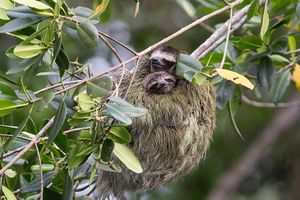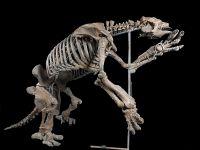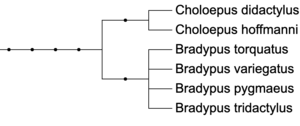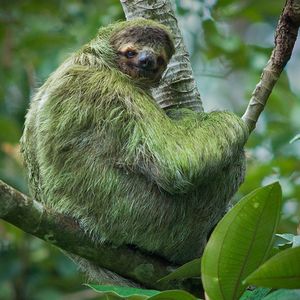Sloth evolution: Difference between revisions
| (47 intermediate revisions by the same user not shown) | |||
| Line 1: | Line 1: | ||
==Introduction== | ==Introduction== | ||
[[Image:Sloths hugging .jpg|thumb|300px|right| Fig. 1 <i>Bradypus pygmaeus</i>, a species of three-toed sloth, holding its baby. https://www.biographic.com/keeping-pygmy-sloths-afloat/]]Despite their similar appearances, the rise of modern sloths is an interesting story of convergent evolution. There are two families of sloths, the two-toed sloth and the three-toed sloth, but there are six different species total. Two-toed sloths belong to the genus <i>Choloepus</i> and three-toed sloths belong to the genus <i>Bradypus</i>. Known for their slow movements and inefficient digestive systems, these creatures populate South American and Central American rainforests. Their diets mainly consist of leaves and fruits. All species of sloths spend their time in the rainforest canopy, spending between 15-20 hours a day sleeping, and only venturing to the floor in order to defecate.<ref name = | [[Image:Sloths hugging .jpg|thumb|300px|right| Fig. 1 <i>Bradypus pygmaeus</i>, a species of three-toed sloth, holding its baby. https://www.biographic.com/keeping-pygmy-sloths-afloat/]]Despite their similar appearances, the rise of modern sloths is an interesting story of convergent evolution. There are two families of sloths, the two-toed sloth and the three-toed sloth, but there are six different species total. Two-toed sloths belong to the genus <i>Choloepus</i> and three-toed sloths belong to the genus <i>Bradypus</i>. Known for their slow movements and inefficient digestive systems, these creatures populate South American and Central American rainforests. Their diets mainly consist of leaves and fruits. All species of sloths spend their time in the rainforest canopy, spending between 15-20 hours a day sleeping, and only venturing to the floor in order to defecate.<ref name = z>Gardner, Alfred L. “Sloth.” Encyclopædia Britannica, Encyclopædia Britannica, Inc., 13 June 2019, https://www.britannica.com/animal/sloth.</ref> The forest floor is full of predators that sloths mainly avoid by hiding in the forest canopy. Although both genera of sloths move little, the three-toed sloth moves an average of 5.4 hectares, while the two-toed sloth moves up to 140 hectares per day.<ref name = z/> Their slow movements are due to their extremely slow metabolism, as they attempt to conserve energy by controlling movement speed. While they move slowly on land, they move significantly quicker in water. This ability frequently results in sloths swimming as opposed to walking on the forest floor. Sloths are solitary in nature, and spend most of their lives alone. The mating habits of sloths are unique, as they spend majority of their time in the trees, meaning they mate and give birth in the trees.<ref name= z/> A female will call to attract a male, and the males that find her will fight in order to gain access to the female. | ||
The evolution and microbiota of sloths are unique due to the animal's ancestors and the various fungi and bacteria that populate the coarse fur of the organism. The evolution of sloths is interesting because two and three toed sloths appear very closely related, but it has recently been suggested that they have vastly different ancestors, meaning that they evolved through convergent evolution. It was previously believed that these two groups of sloths diverged from the same ancestor, but this was a misconception in the science community. A better example of divergent evolution would be the evolution of dog breeds. Although the sloths belong to different families, they both have similar microbiota. The microbiota of sloths are the microorganisms that live within or on the sloth. The fur of the sloth is made of microorganisms that the sloth benefit from through a mutualistic relationship. The algae that grows within the fur of the sloth is essential for nutrients and digestion. It also promotes a mutualistic relationship between the sloth and moth species that are dependent on the sloth. | |||
==Genetics/Evolution== | ==Genetics/Evolution== | ||
[[Image: giant3.jpg|thumb|200px|left| Fig. 2 Image of a giant ground sloth. https://www.smithsonianmag.com/smithsonian-institution/giant-sloth-mystery-brought-me-home-georgia-180972059/]]Two-toed and three-toed sloths subside on the same diet and belong to the same order, Pilosa. Phenotypically, they appear almost identical, with the main distinguishing feature being their number of toes. These similar features would make them appear very closely related. However, these two sloths do not belong to the same family. Besides the difference between the number of toes each species has, they also differ in the number of vertebrae in their spines and several other morphological features. By examining the traits of the sloths like locomotion and suspensory posture,<ref>Nyakatura, J.A. 2012. The Convergent Evolution of Suspensory Posture and Locomotion in Tree Sloths. J Mammal Evol 19: 225. https://doi.org/10.1007/s10914-011-9174-x</ref> it was discovered that the <i>Bradypus</i> and <i>Choloepus</i> species evolved through convergent evolution, which is where organisms with different ancestors or from different periods evolved similar | [[Image: giant3.jpg|thumb|200px|left| Fig. 2 Image of a giant ground sloth. https://www.smithsonianmag.com/smithsonian-institution/giant-sloth-mystery-brought-me-home-georgia-180972059/]]Two-toed and three-toed sloths subside on the same diet and belong to the same order, Pilosa. Phenotypically, they appear almost identical, with the main distinguishing feature being their number of toes. The hands and claws of the sloth have changed over time to resemble hooks that are used in order to hang from trees with limited effort. The ligaments and muscles of the sloth are not strained when hanging from the trees, another important evolutionary adaptation of the sloth.<ref>“The Sloth's Evolutionary Secret.” National Geographic, 3 Jan. 2012, https://www.nationalgeographic.com/science/phenomena/2012/01/03/the-sloths-evolutionary-secret/.</ref> These similar features would make them appear very closely related. However, these two sloths do not belong to the same family. Besides the difference between the number of toes each species has, they also differ in the number of vertebrae in their spines and several other morphological features. By examining the traits of the sloths like locomotion and suspensory posture,<ref>Nyakatura, J.A. 2012. The Convergent Evolution of Suspensory Posture and Locomotion in Tree Sloths. J Mammal Evol 19: 225. https://doi.org/10.1007/s10914-011-9174-x.</ref> it was discovered that the <i>Bradypus</i> and <i>Choloepus</i> species evolved through convergent evolution, which is where organisms with different ancestors or from different periods evolved similar phenotypes or traits. | ||
[[Image: Phylogeny2.png|thumb|300px|right| Fig. 3 A modern phylogeny containing all sloth species, created using the phyloT tree generator. https://phylot.biobyte.de/index.cgi]] | |||
Amino acid sequences also supported the new familial groupings of sloths. Researchers examined the collagen in fossils from extinct species.<ref name = bob>Presslee, S., Slater, G.J., Pujos, F. et al. 2019. Palaeoproteomics resolves sloth relationships. Nat Ecol Evol 3, 1121–1130 doi:10.1038/s41559-019-0909-z.</ref> This was done because DNA is normally unable to be extracted from fossils. The collagen was used to recreate the proteins of the extinct animals. Through this process, it was revealed that the two-toed sloth is grouped with the family Megalonychidae, which encompasses ground sloths, including the giant land sloth.<ref name = bob/> The three-toed sloths were grouped with the Bradypodidae family. This means that two and three-toed sloths are not closely related. Instead, they evolved to have similar phenotypes through convergent evolution. | |||
<br></br> | <br></br> | ||
<br></br> | <br></br> | ||
==Microbiome== | ==Microbiome== | ||
[[Image: Algae2.jpg|thumb|300px|right| Fig. | [[Image: Algae2.jpg|thumb|300px|right| Fig. 4 Image of a three-toed sloth with algae in its fur. https://www.google.com/url?sa=i&source=images&cd=&ved=2ahUKEwiypZyng5bmAhUCCKwKHSJ9DMkQjRx6BAgBEAQ&url=https%3A%2F%2Fwww.pinterest.com%2Fpin%2F173881235585118104%2F&psig=AOvVaw3Jj6J1OEqEa-091RNvBIBB&ust=1575343664470735]]Sloths have a mutualistic relationship with moths that live in their fur.<ref name = rachel>Pauli, J. N., Mendoza, J. E., Steffan, S. A., Carey, C. C., Weimer, P. J., & Peery, M. Z. (2014). A syndrome of mutualism reinforces the lifestyle of a sloth. Proceedings of the Royal Society B: Biological Sciences, 281(1778), 20133006. doi: 10.1098/rspb.2013.3006.</ref> The algae that grows in sloth fur not only camouflages the sloths in the tree canopy, but also provides a source of nutrients for the sloths. The algae is rich in lipids and aids in digestion. This is essential for the sloth, because they only defecate once a week. If they do not have regular bowel movements, this increases the mass of the sloth, and can increase the risk of falling from the tree. Although the spines of sloths are flexible, falling from a high enough height can kill a sloth. Their predators are also abundant on the forest floor making any time spent on the ground dangerous. This means that the weekly trips to the ground to defecate are also dangerous for sloths. In order to survive, a short time spent defecating is necessary.<br></br> One of the main mysteries of sloths was their purpose in venturing to the forest floor to defecate. This has recently been explained by research about the mutualistic relationship that exists between sloths and moths. The amount of algae that grows in a sloth's fur is dependent on these moths. There are several species that colonize sloth fur, where they mate and live. By living in sloth fur, these moths avoid predators and have a steady food source, the algae. When the sloth climbs down the tree to defecate, a female moth will lay her eggs in the feces of the sloth. When the eggs hatch, the juvenile moths then return to a sloth's fur, where they grow and the cycle repeats. Recent research suggests that sloth moths increase the amount of nitrogen that is present in sloth fur.<ref name = rachel/> The more abundant nitrogen is, the more the algae grows. The three-toed sloths appear to have a higher concentration of moths and algae, which may be due to the more limited movement of the three-toed sloth. The sloths are dependent on this algae, which is a proposed explanation for why they aid in the life cycle of the moths by climbing down the trees to defecate. | ||
==Conclusion== | ==Conclusion== | ||
[[Image: Moe.JPG|thumb|150px|left| Fig. | [[Image: Moe.JPG|thumb|150px|left| Fig. 5 Moe the sloth from the Cincinnati Zoo. Photo taken by Cassandra Lis.]] | ||
Two-toed and three-toed sloths | Two-toed and three-toed sloths are more distantly related than previously believed. Research suggests that they evolved from different families of extinct animals, meaning they evolved through convergent evolution. However, both of these sloths are similar in the cultivation of algae in their fur to promote digestion. The moths that live in their fur are also essential in the growth of algae. Both two and three-toed sloths have filled a similar niche in forest environments, despite their differing ancestry. | ||
==References== | ==References== | ||
Latest revision as of 03:26, 7 December 2019
Introduction

Despite their similar appearances, the rise of modern sloths is an interesting story of convergent evolution. There are two families of sloths, the two-toed sloth and the three-toed sloth, but there are six different species total. Two-toed sloths belong to the genus Choloepus and three-toed sloths belong to the genus Bradypus. Known for their slow movements and inefficient digestive systems, these creatures populate South American and Central American rainforests. Their diets mainly consist of leaves and fruits. All species of sloths spend their time in the rainforest canopy, spending between 15-20 hours a day sleeping, and only venturing to the floor in order to defecate.[1] The forest floor is full of predators that sloths mainly avoid by hiding in the forest canopy. Although both genera of sloths move little, the three-toed sloth moves an average of 5.4 hectares, while the two-toed sloth moves up to 140 hectares per day.[1] Their slow movements are due to their extremely slow metabolism, as they attempt to conserve energy by controlling movement speed. While they move slowly on land, they move significantly quicker in water. This ability frequently results in sloths swimming as opposed to walking on the forest floor. Sloths are solitary in nature, and spend most of their lives alone. The mating habits of sloths are unique, as they spend majority of their time in the trees, meaning they mate and give birth in the trees.[1] A female will call to attract a male, and the males that find her will fight in order to gain access to the female.
The evolution and microbiota of sloths are unique due to the animal's ancestors and the various fungi and bacteria that populate the coarse fur of the organism. The evolution of sloths is interesting because two and three toed sloths appear very closely related, but it has recently been suggested that they have vastly different ancestors, meaning that they evolved through convergent evolution. It was previously believed that these two groups of sloths diverged from the same ancestor, but this was a misconception in the science community. A better example of divergent evolution would be the evolution of dog breeds. Although the sloths belong to different families, they both have similar microbiota. The microbiota of sloths are the microorganisms that live within or on the sloth. The fur of the sloth is made of microorganisms that the sloth benefit from through a mutualistic relationship. The algae that grows within the fur of the sloth is essential for nutrients and digestion. It also promotes a mutualistic relationship between the sloth and moth species that are dependent on the sloth.
Genetics/Evolution

Two-toed and three-toed sloths subside on the same diet and belong to the same order, Pilosa. Phenotypically, they appear almost identical, with the main distinguishing feature being their number of toes. The hands and claws of the sloth have changed over time to resemble hooks that are used in order to hang from trees with limited effort. The ligaments and muscles of the sloth are not strained when hanging from the trees, another important evolutionary adaptation of the sloth.[2] These similar features would make them appear very closely related. However, these two sloths do not belong to the same family. Besides the difference between the number of toes each species has, they also differ in the number of vertebrae in their spines and several other morphological features. By examining the traits of the sloths like locomotion and suspensory posture,[3] it was discovered that the Bradypus and Choloepus species evolved through convergent evolution, which is where organisms with different ancestors or from different periods evolved similar phenotypes or traits.

Amino acid sequences also supported the new familial groupings of sloths. Researchers examined the collagen in fossils from extinct species.[4] This was done because DNA is normally unable to be extracted from fossils. The collagen was used to recreate the proteins of the extinct animals. Through this process, it was revealed that the two-toed sloth is grouped with the family Megalonychidae, which encompasses ground sloths, including the giant land sloth.[4] The three-toed sloths were grouped with the Bradypodidae family. This means that two and three-toed sloths are not closely related. Instead, they evolved to have similar phenotypes through convergent evolution.
Microbiome

Sloths have a mutualistic relationship with moths that live in their fur.[5] The algae that grows in sloth fur not only camouflages the sloths in the tree canopy, but also provides a source of nutrients for the sloths. The algae is rich in lipids and aids in digestion. This is essential for the sloth, because they only defecate once a week. If they do not have regular bowel movements, this increases the mass of the sloth, and can increase the risk of falling from the tree. Although the spines of sloths are flexible, falling from a high enough height can kill a sloth. Their predators are also abundant on the forest floor making any time spent on the ground dangerous. This means that the weekly trips to the ground to defecate are also dangerous for sloths. In order to survive, a short time spent defecating is necessary.
One of the main mysteries of sloths was their purpose in venturing to the forest floor to defecate. This has recently been explained by research about the mutualistic relationship that exists between sloths and moths. The amount of algae that grows in a sloth's fur is dependent on these moths. There are several species that colonize sloth fur, where they mate and live. By living in sloth fur, these moths avoid predators and have a steady food source, the algae. When the sloth climbs down the tree to defecate, a female moth will lay her eggs in the feces of the sloth. When the eggs hatch, the juvenile moths then return to a sloth's fur, where they grow and the cycle repeats. Recent research suggests that sloth moths increase the amount of nitrogen that is present in sloth fur.[5] The more abundant nitrogen is, the more the algae grows. The three-toed sloths appear to have a higher concentration of moths and algae, which may be due to the more limited movement of the three-toed sloth. The sloths are dependent on this algae, which is a proposed explanation for why they aid in the life cycle of the moths by climbing down the trees to defecate.
Conclusion
Two-toed and three-toed sloths are more distantly related than previously believed. Research suggests that they evolved from different families of extinct animals, meaning they evolved through convergent evolution. However, both of these sloths are similar in the cultivation of algae in their fur to promote digestion. The moths that live in their fur are also essential in the growth of algae. Both two and three-toed sloths have filled a similar niche in forest environments, despite their differing ancestry.
References
- ↑ 1.0 1.1 1.2 Gardner, Alfred L. “Sloth.” Encyclopædia Britannica, Encyclopædia Britannica, Inc., 13 June 2019, https://www.britannica.com/animal/sloth.
- ↑ “The Sloth's Evolutionary Secret.” National Geographic, 3 Jan. 2012, https://www.nationalgeographic.com/science/phenomena/2012/01/03/the-sloths-evolutionary-secret/.
- ↑ Nyakatura, J.A. 2012. The Convergent Evolution of Suspensory Posture and Locomotion in Tree Sloths. J Mammal Evol 19: 225. https://doi.org/10.1007/s10914-011-9174-x.
- ↑ 4.0 4.1 Presslee, S., Slater, G.J., Pujos, F. et al. 2019. Palaeoproteomics resolves sloth relationships. Nat Ecol Evol 3, 1121–1130 doi:10.1038/s41559-019-0909-z.
- ↑ 5.0 5.1 Pauli, J. N., Mendoza, J. E., Steffan, S. A., Carey, C. C., Weimer, P. J., & Peery, M. Z. (2014). A syndrome of mutualism reinforces the lifestyle of a sloth. Proceedings of the Royal Society B: Biological Sciences, 281(1778), 20133006. doi: 10.1098/rspb.2013.3006.
Edited by Cassandra Lis, student of Joan Slonczewski for BIOL 116 Information in Living Systems, 2019, Kenyon College.

